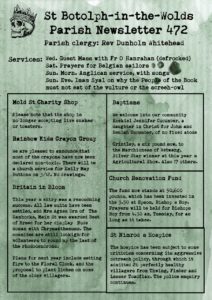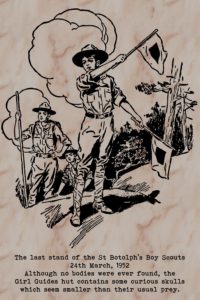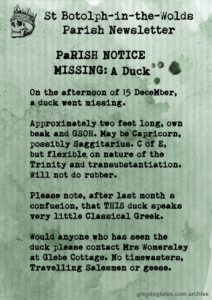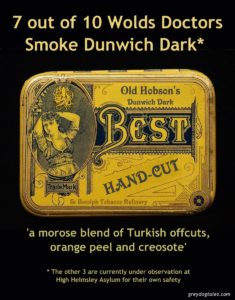Today, dear listener, we bow to both popular and unpopular demand, and offer you a brief excursion to the parish of St Botolph-in-the-Wolds, in darkest Yorkshire. A location of which H P Lovecraft once said:
“I shall no doubt have to tone this benighted place down if I want to base my modest tales upon it. It contains such peculiar horrors that no editor is likely to respond with any kindness.” (Note to his milkman, 15th July 1923)
For those new to the subject, St Botolph-in-the-Wolds might be described as a sleepy English Parish set in the rolling countryside of East Yorkshire, far from the hustle and bustle of city life. A village where everyone knows each other, and life is much the same as it was centuries ago.
This would be a stupid description.
It may be geographically correct, but life in St Botolph’s is complex, argumentative and filled with new terrors every day. More than one resident dreams of escaping to find peace in a violent urban crack ghetto, surrounded by burning tyres and daily police raids. People may indeed know their neighbours, but they may not always be sure what their neighbours are.
It should be noted that the Concerned Ladies Committee of the village, formed originally for charitable acts, is mostly concerned about having to live in St Botolph-in-the-Wolds. Members of the Women’s Institute are heavily armed, and the local Girl Guides are seriously feral, with a long-term Brasso addiction.
The main village choral society is the The Children of the Empty Furrow, described as:
“The Yorkshire Wolds’ outstanding primitive folk group.” (Poultry Botherers’ Gazette, 2011).
Their most popular songs include:
- ‘The Earth Bleeds, and the Seas Burn: My Scorched Lungs Sing of Thee’ (acapello)
- ‘The Drums of God are Made from the Flayed Skin of His Enemies’
- ‘Why Do Your Eyes Bleed in the Sunlight, Mother?’ (duet)
- ‘The Old Wicker Tree on the Hill’ (traditional)
- ‘Lemon Tree’ (hardcore blood-rage version, arr. Nina and Fredrik)
If You Go Down to the Woods Today
Scholars are divided as to what makes St Botolph’s so unusual. There is no doubt that the looming presence of Whateley Wood, north of the village proper, plays its part. Home to the oak, the Western Hemlock and an especially offensive type of briar, the woods contain many remains of early fertility and sacrificial cults.
These include obscenely carved altars – where the Womens’ Institute leaves offerings of home-made raspberry jam at key times of the year – and a gleaming black stone from antiquity, whose surface is chill and moist even on the hottest day. This stands alone in a clearing which smells of charred bone, and is marked ‘Pickering 14 miles’. The sheer malevolence of the woods can be seen from the fact that Pickering is not actually 14 miles away. And it’s in the other direction.
Paths through the woods often appear and disappear at random. The unwary traveller may find themselves lost in a ravening gloom, surrounded by nightjacks and tendrilled things – or worse, may end up at Malton bus station. The main section is also inhabited by a large colony of bronchitic whip-poor-wills. Normally typical of the witch-haunted hills of New England, these small, coughing birds are always on the lookout for souls to conduct into the Afterlife.
Or perhaps its origins are to blame. It has been variously claimed that the village started life as:
- A Bronze Age ritual site for the disposal of unwanted otters
- A shrine to Botothqua, Mother of Persistent Slime, worshipped by at least three people in the early Iron Age but somewhat neglected since 557 BCE*
- An open toilet for the Auxiliary Roman Cavalry unit based at Malton
- A failed attempt at creating a refuge for agoraphobic Vikings
*See ‘Mucus and Myth: The Peculiar Deposits on some Northern La Tene Artifacts’, Ichabod James Marsh (BChD), Journal of Unreliable Archaeology, XVI, pp23-48)
St Botolph’s – Fact and Fiction
There is no single agreed origin for the settlement of St Botolph’s. The prominent local scholar J Linseed Grant records in his journal that the village can be traced back to at least 416 CE and the story of St Bortulf:
“According to local legend, Bortulf was a learned man who spent his entire life studying the humble badger, even to the point of entering the larger setts and recording the intimate activities of these friendly, sociable creatures. After his sudden death from multiple badger bites, his remains were taken to be buried in the River Ouse. This endeavour took the lives of three successive gravediggers before his wife remembered that Bortulf had said ‘by the river’, not in it. St. Bortulf is known today as the Patron Saint of Shaving Brush Manufacturers and people who forget to take out an index-linked pension. He is not widely venerated, even here…”
(Note: Bortulf has been shown to have nothing to do with the other St Botolph, nee Botwulf, an English abbot and patron saint of travellers, who preferred East Anglia to East Yorkshire.)
Stories of the past are common currency in St Botolph’s, many of them highly dubious. There is no doubt, though, that in Victorian times the village was genuinely home to Ebediah Crake, the least successful Wolds murderer in history. J Linseed Grant says of him:
“In 1839 he failed to kill an entire family of seven living just outside York, being distracted by ‘a littul kitten what had a poorly paw.’ And in September 1842, Crake helped a frail old lady into a carriage and then secured her luggage to the rear, telling the driver to go gently.
“His actual instructions, from one Septimus Grange, an itinerant ferret-grinder, had been to garotte her and leave the body in a ditch so that they could share the contents of her purse. Grange was later hanged for interfering with two unrelated goats.”
There are many other examples of folklore. The tale of mist-shrouded Cooper’s Field, northwest of the village, is always popular at Bar Mitzvahs:
“Legend had it that a skilled cooper once set up his trade there, relying on the woods to supply timber for his intricately fashioned barrels. Not long after, he died. It wasn’t much of a legend, really.”
St Botolph’s is also on the edge of the Wold Newton Triangle, an area long known for its strange meteorites, disappearing rivers, early mounds and so forth. So that probably helps. With Grimdyke Moors, Whateley Wood and a range of stark, haunted crags surrounding the village, Yorkshire temperament must play a part in keeping humanity present in a location for which it is hardly suited. That, and a poor sense of direction.
Despite the fact that the Ordnance Survey have refused to mark St Botolph’s on the official maps, citing public safety concerns, certain authorities such as the military are aware of it. RAF pilots, for example, have strict instructions not to fly over the area, ever since one of the Tornadoes from Staxton Wold came back with more wings than it had when it set out.
And given all the above, it is perhaps no surprise that religion plays a large part in the life of St Botolph’s. We may yet visit that subject in a later article.
Or we may go and worm the dogs. Literary decision-making is always such a struggle. For now we shall leave you with the words of the ever-reliable J Linseed Grant on his native land:
“Went for a walk. Couldn’t find one. On the moors, a large pony appeared to be dismembering something pallid and fungoid. The pony seemed to be enjoying himself; the pallid, fungoid thing not so much. Do not think this village will be winning any Picturesque Britain awards. The floral clock is stuck at five past twenty seven again…”
The Journal of J Linseed Grant is explored every few days in jlg’s Facebook entries, usually with dire results. St Botolph’s features in many stories on greydogtales (and the odd one elsewhere). And as Easter is coming up, you can discover the true meaning of Christmas here, in a St Botolph’s tale entitled ‘A Midwinter Night’s Carol’.





